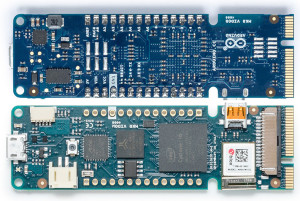Arduino Vidor: An FPGA for everyone?
February 21, 2019
on
on
Ad augusta per angusta
 It wasn’t so long ago, you would remember the first time you heard of an Arduino based FPGA board. Like almost everybody, you no doubt had a mixed reaction to this news. You raised your right eyebrow enthusiastically at the glorious visions conjured up by the abbreviation FPGA. This integrated circuit remains mythical among many, also in the history of Elektor: back in 2006, Elektor published in its columns a course on FPGAs which remains fresh in the memory of many readers. At the same time, though, your left eyebrow was frowning, twisted at the agonizing prospect endless hours of obstinate tapping in front of the screen, Yes, FPGAs are like a rodeo. You’ll get there, as long as you can stay in the saddle till the end!
It wasn’t so long ago, you would remember the first time you heard of an Arduino based FPGA board. Like almost everybody, you no doubt had a mixed reaction to this news. You raised your right eyebrow enthusiastically at the glorious visions conjured up by the abbreviation FPGA. This integrated circuit remains mythical among many, also in the history of Elektor: back in 2006, Elektor published in its columns a course on FPGAs which remains fresh in the memory of many readers. At the same time, though, your left eyebrow was frowning, twisted at the agonizing prospect endless hours of obstinate tapping in front of the screen, Yes, FPGAs are like a rodeo. You’ll get there, as long as you can stay in the saddle till the end!
New ground, high expectations
The new Arduino MKR VIDOR 4000 board has been available in the Elektor Store for some time now. With an Intel 10CL016 FPGA. That’s 16,000 logic elements plus some specialised signal processing embedded multipliers (read: audio and video). The board, at 83 x 25 mm (3.3 x 1 inches) is as full as an egg. In addition to standard GPIOs, there are HDMI, USB, JST and MIPI (Camera) connectors. And let’s not forget the ARM ATSAMD21 32-bit microcontroller!In announcing its availability, I searched for a suitable video. Something interesting, which does not just go over Mr. Banzi’s well intentioned promises. For example, a video which illustrates the first steps with this board. Spoiled as we are by the plethora of unusual and successful applications which the Arduino has brought us, our expectations are pretty high. Now, less than 6 months after the marriage of the Arduino with an FPGA, the ground seems practically unexplored, judging by the small number of available videos.
I found merit in the attempt below. It’s a ‘demystification’, delivered live by someone who does not pose as a specialist and does not have hours of obvious prior training. This gives us a video which is quite spontaneous, at an accessible level. An accessibility which, for want of editing of the hesitations of working live, unfortunately makes for quite a long video.
Anyone who has asked themselves the question posed in the title should give it a try!
Read full article
Hide full article


Discussion (0 comments)